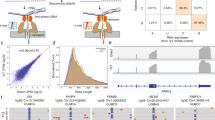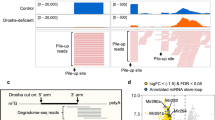Abstract
In this protocol, I describe a method for measuring the frequency of adenosine-to-inosine RNA editing of primary, precursor and mature forms of specific microRNAs (miRNAs) derived from the same source. The procedure involves reverse transcription (RT)-PCR amplification of regions containing the editing sites followed by subcloning of the PCR products and sequencing. In contrast to deep sequencing, this method does not require any specialized equipment. Pri-miRNAs, which are relatively long primary transcripts, are amplified using a conventional RT-PCR method. Therefore, this method can be adapted for any known RNA-editing sites. In contrast, 3′ polyadenylation followed by 5′ adaptor ligation is indispensable for amplification of pre-miRNAs and mature miRNAs. The complete protocol takes ∼1 week. I also include details of direct sequence analysis of the PCR products derived from pri-miRNAs as an alternative method. Although it is not as precise as the subcloning method, this procedure enables us to study RNA-editing events of many samples.
This is a preview of subscription content, access via your institution
Access options
Subscribe to this journal
Receive 12 print issues and online access
$259.00 per year
only $21.58 per issue
Buy this article
- Purchase on Springer Link
- Instant access to full article PDF
Prices may be subject to local taxes which are calculated during checkout



Similar content being viewed by others
References
Chekulaeva, M. & Filipowicz, W. Mechanisms of miRNA-mediated post-transcriptional regulation in animal cells. Curr. Opin. Cell Biol. 21, 452–460 (2009).
Han, J. et al. The Drosha-DGCR8 complex in primary microRNA processing. Genes Dev. 18, 3016–3027 (2004).
Denli, A.M., Tops, B.B., Plasterk, R.H., Ketting, R.F. & Hannon, G.J. Processing of primary microRNAs by the microprocessor complex. Nature 432, 231–235 (2004).
Gregory, R.I. et al. The microprocessor complex mediates the genesis of microRNAs. Nature 432, 235–240 (2004).
Chendrimada, T.P. et al. TRBP recruits the Dicer complex to Ago2 for microRNA processing and gene silencing. Nature 436, 740–744 (2005).
Gregory, R.I., Chendrimada, T.P., Cooch, N. & Shiekhattar, R. Human RISC couples microRNA biogenesis and posttranscriptional gene silencing. Cell 123, 631–640 (2005).
Du, T. & Zamore, P.D. microPrimer: the biogenesis and function of microRNA. Development 132, 4645–4652 (2005).
Siomi, H. & Siomi, M.C. Posttranscriptional regulation of microRNA biogenesis in animals. Mol. Cell 38, 323–332 (2010).
Newman, M.A. & Hammond, S.M. Emerging paradigms of regulated microRNA processing. Genes Dev. 24, 1086–1092 (2010).
Yang, W. et al. Modulation of microRNA processing and expression through RNA editing by ADAR deaminases. Nat. Struct. Mol. Biol. 13, 13–21 (2006).
Kawahara, Y. et al. Redirection of silencing targets by adenosine-to-inosine editing of miRNAs. Science 315, 1137–1140 (2007).
Kawahara, Y., Zinshteyn, B., Chendrimada, T.P., Shiekhattar, R. & Nishikura, K. RNA editing of the microRNA-151 precursor blocks cleavage by the Dicer-TRBP complex. EMBO Rep. 8, 763–769 (2007).
Kawahara, Y. et al. Frequency and fate of microRNA editing in human brain. Nucleic Acids Res. 36, 5270–5280 (2008).
Wulff, B.E. & Nishikura, K. Modulation of microRNA expression and function by ADARs. Curr. Top. Microbiol. Immunol. 353, 91–109 (2012).
Hundley, H.A. & Bass, B.L. ADAR editing in double-stranded UTRs and other noncoding RNA sequences. Trends Biochem. Sci. 35, 377–383 (2010).
Jepson, J.E. & Reenan, R.A. RNA editing in regulating gene expression in the brain. Biochim. Biophys. Acta. 1779, 459–470 (2008).
Farajollahi, S. & Maas, S. Molecular diversity through RNA editing: a balancing act. Trends Genet. 26, 221–230 (2010).
Luciano, D.J., Mirsky, H., Vendetti, N.J. & Maas, S. RNA editing of a miRNA precursor. RNA 10, 1174–1177 (2004).
Blow, M.J. et al. RNA editing of human microRNAs. Genome Biol. 7, R27 (2006).
Iizasa, H. et al. Editing of Epstein-Barr virus-encoded BART6 microRNAs controls their dicer targeting and consequently affects viral latency. J. Biol. Chem. 285, 33358–33370 (2010).
Landgraf, P. et al. A mammalian microRNA expression atlas based on small RNA library sequencing. Cell 129, 1401–1414 (2007).
Chiang, H.R. et al. Mammalian microRNAs: experimental evaluation of novel and previously annotated genes. Genes Dev. 24, 992–1009 (2010).
Berezikov, E. et al. Deep annotation of Drosophila melanogaster microRNAs yields insights into their processing, modification, and emergence. Genome Res. 21, 203–215 (2011).
Iwamoto, K., Bundo, M. & Kato, T. Estimating RNA editing efficiency of five editing sites in the serotonin 2C receptor by pyrosequencing. RNA 11, 1596–1603 (2005).
Morabito, M.V. et al. High-throughput multiplexed transcript analysis yields enhanced resolution of 5-hydroxytryptamine 2C receptor mRNA editing profiles. Mol. Pharmacol. 77, 895–902 (2010).
Abbas, A.I. et al. Assessing serotonin receptor mRNA editing frequency by a novel ultra high-throughput sequencing method. Nucleic Acids Res. 38, e118 (2010).
Silberberg, G. & Ohman, M. The edited transcriptome: novel high throughput approaches to detect nucleotide deamination. Curr. Opin. Genet. Dev. 21, 401–406 (2011).
O'Neil, R.T. & Emeson, R.B. Quantitative analysis of 5HT(2C) receptor RNA editing patterns in psychiatric disorders. Neurobiol. Dis. 45, 8–13 (2012).
Dupuis, D.E. & Maas, S. MiRNA editing. Methods Mol. Biol. 667, 267–279 (2010).
Fu, H. et al. Identification of human fetal liver miRNAs by a novel method. FEBS Lett. 579, 3849–3854 (2005).
Kawamura, Y. et al. Drosophila endogenous small RNAs bind to Argonaute 2 in somatic cells. Nature 453, 793–797 (2008).
Gurevich, I. et al. Altered editing of serotonin 2C receptor pre-mRNA in the prefrontal cortex of depressed suicide victims. Neuron 34, 349–356 (2002).
Eggington, J.M., Greene, T. & Bass, B.L. Predicting sites of ADAR editing in double-stranded RNA. Nat. Commun. 2, 319 (2011).
Acknowledgements
I thank K. Nishikura for helpful discussion and A. Mieda-Sato for technical assistance. This work was supported by the Osaka University Life Science Young Independent Researcher Support Program through the Special Coordination Program to Disseminate Tenure Tracking System from the Ministry of Education, Culture, Sports, Science and Technology-Japan (MEXT); and it was supported by Grants-in-Aid for Scientific Research (B) (no. 22390176), for Challenging Exploratory Research (no. 23659453) and for Scientific Research on Innovative Areas 'RNA regulation' (no. 23112712) from MEXT (to Y.K.).
Author information
Authors and Affiliations
Contributions
Y.K. designed the experiments and wrote the manuscript.
Corresponding author
Ethics declarations
Competing interests
The author declares no competing financial interests.
Supplementary information
Supplementary Fig. 1
Example of how the editing frequency is calibrated. (a) The sequence of human pri-miR-151 is shown. The regions known to be processed into mature miR-151-5p and miR-151-3p are shown in green. Two adenosine bases known to be subject to RNA editing (-1 and +3 sites) are indicated in red. (b) A chromatogram showing the results of direct DNA sequencing of RT-PCR products corresponding to the pri-miR-151 region amplified from human total brain and those of the combination of edited and unedited versions of the plasmid DNA mixed at the ratio shown on the left. The positions of the two editing sites are indicated by red arrows. (c) The regression lines are drawn between the observed ratio obtained from measuring the peak heights of A and G bases at the editing site in the chromatogram (Y axis) and the combined ratio (X axis) for the two editing sites (-1 and +3 sites; n = 3). The observed ratio as well as the calibrated editing frequency of the two editing sites in pri-miR-151 derived from human total brain is also shown in red. (PDF 124 kb)
Supplementary Fig. 2
The protocol to amplify pre-miRNAs that have the editing site in the 5′-proximal half of the RNA. The editing site, the terminal loop region and region corresponding to mature miRNAs are shown in red, gray and green, respectively. The numbers of the corresponding steps in the Procedure are shown on the right side. After the fractionated small RNAs are polyadenylated, a 5′ adaptor RNA is ligated using T4 RNA ligase. RT is then performed using oligo (dT)30 primer that is ligated to a linker sequence at the 5′ end (RT2). The resultant cDNA is then amplified by PCR using pre-miRNA-specific primer pairs. PCR products can be amplified by two alternative primer pairs (FW3/RV3 or FW4/RV4). The FW4 primer only contains the 5′ adaptor sequence, whereas the FW3 primer consists of the 5′ adaptor sequence and a few nucleotides of the target pre-miRNA. The RV4 primer mainly consists of the terminal loop sequence, whereas the RV3 primer mainly consists of the 3′-proximal half of the target pre-miRNA. The PCR products are gel purified and then subcloned into plasmids. At least 50 cDNA isolates are then sequenced. (PDF 53 kb)
Supplementary Methods
Calibration of the editing frequency of pri-miRNAs from the raw data obtained by the direct sequencing method. (PDF 22 kb)
Rights and permissions
About this article
Cite this article
Kawahara, Y. Quantification of adenosine-to-inosine editing of microRNAs using a conventional method. Nat Protoc 7, 1426–1437 (2012). https://doi.org/10.1038/nprot.2012.073
Published:
Issue Date:
DOI: https://doi.org/10.1038/nprot.2012.073
This article is cited by
-
Role of phasiRNAs from two distinct phasing frames of GhMYB2 loci in cis- gene regulation in the cotton genome
BMC Plant Biology (2020)
-
Transcriptome-wide identification of adenosine-to-inosine editing using the ICE-seq method
Nature Protocols (2015)
-
VIRGO: visualization of A-to-I RNA editing sites in genomic sequences
BMC Bioinformatics (2013)
Comments
By submitting a comment you agree to abide by our Terms and Community Guidelines. If you find something abusive or that does not comply with our terms or guidelines please flag it as inappropriate.



